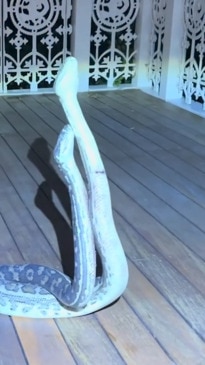Everything you need to know about snake season in Qld
Australia and snakes go hand in hand but what do you do if you get bitten? ALL YOUR QUESTIONS ANSWERED

Australia and snakes go hand in hand but what do you do if you get bitten?
And what are the most deadly snakes in Australia and how do I spot them (full list here)?
We answer all your questions below >>>
What time of year do we see the most snakes in Qld?
In Queensland snakes are most active during snake season which begins about September and runs until April.
When the weather warms up and spring arrives we begin to see snakes emerge from their brumate period.
Brumation, a form of dormancy in reptiles, is similar to hibernation.
What do I do if I see a snake?
According to the Queensland Government website: “Don’t panic. Back away to a safe distance and allow the snake to move away. Snakes often want to escape when disturbed. Remember, all native wildlife, including snakes, is protected.”
If the snake is in your house, it is important that you never try to kill the snake.
Not only is it illegal to kill a native animal, but it places you at a higher risk of being bitten if you force the snake to defend itself.
Close the internal doors in the house and open the external doors and windows. Block the gaps underneath internal doors with rolled up towels. Place chairs and boxes under windows to make it easier for snakes to climb out. Keep everyone well clear of the snake.
Call RSPCA Qld on 1300 264 625 or contact your nearest snake specialist.
How can I protect my pets from snakes?
Snakes are attracted to food and water sources and quiet places.
To reduce the risk keep the grass low, clean up rubbish piles and clear away areas where snakes can hide.
You could also consider building a snake-proof fence around your property.
If you are walking your dog keep your dog on a leash and avoid long grassy areas.
It’s also best to keep cats indoors.
Source: RSPCA
What do I do if I get bitten by a snake?
– Keep the person at rest, reassured and under observation.
– Dial 000.
– Do not wash venom off the skin or clothes.
– Begin CPR, if necessary. 30 chest compressions per 2 breaths.
– If bitten on a limb, apply a firm bandage on the bite site. Ensure the limb is immobilised and the person remains still.
– Work the bandage from the limb foot or hand upwards, working towards the heart and covering as much of the limb as possible. If you can, apply a splint to keep the limb immobile.
– Keep the person still and reassured until medical attention arrives.
Source: Australian Red Cross
Can I keep a snake if Ifind one?
Under no circumstances can you keep a snake that you have found in the wild. All wildlife in Queensland is protected under the Nature Conservation Act 1992.
It is an offence to keep wild animals, and fines and penalties may apply.
What are the most dangerous types of snakes?
Eastern brown, Inland taipan, red-bellied black snake and death adder are among the most deadly.
However while most snakes have the potential to bite a human, they will generally only bite as a last resort.
Not all snake bites are harmful. Pythons do not have venom and colubrids (rear-fanged snakes) either have a weak venom or lack venom altogether.
You can buy snake bite kits online, generally ranging in price from $10 to $100.
The kits generally contain swabs, blankets, permanent markers, gloves, pressure bandages and CPR instructions.
Full list of dangerous snakes here
What are the signs and symptoms of a snake bite?
The most common symptoms are:
– Nausea, vomiting, or diarrhoea;
– Puncture marks at the wound;
– Rapid heart rate, weak pulse, low blood pressure;
– Redness, swelling, bruising, bleeding, or blistering around the bite;
– Severe pain and tenderness at the site of the bite;
– Labored breathing (in extreme cases, breathing may stop altogether);
– Disturbed vision.
For dogs, the symptoms usually include swelling of the head and face, weakness, particularly in the hind limbs, paralysis and disorientation.

Originally published as Everything you need to know about snake season in Qld


